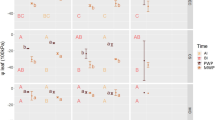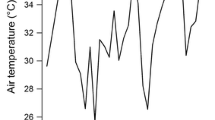Abstract
Water relations of two rapidly expanding species in deforested localities, Calamagrostis epigeios and Calamagrostis arundinacea, were compared. After short- or long-term water stress, water content and specific leaf area were more reduced in C. epigeios than in C. arundinacea. After short-term stress, osmotic potential was similar in both species, but after long-term stress, it was much lower in C. epigeios plants. Abscisic acid and proline contents were higher in stressed plants of C. epigeios than in those of C. arundinacea.
Similar content being viewed by others
References
Gloser, J., Barták, M.: Net photosynthesis, growth rate and biomass allocation in rhizomatous grass Calamagrostis epigelos grown at elevated CO2 concentration.-Photosynthetica 30: 143–150, 1994.
Gloser, V., Gloser, J.: Acclimation capability of Calamagrostis epigeios and C arundinacea to changes in radiation environment.-Photosynthetica 32: 203–212, 1996.
Quarrie, S.A., Whitford, P.N., Appledorf, N.E.J., Wang, T.L., Cook, S.K., Henson, L.E., Loveys, B.R.: A monoclonal antibody to (S)-abscisic acid: its characterisation and use in radioimmunoassay for measuring abscisic acid in crude extracts of cereal and lupin leaves.-Planta 183: 330–339, 1988.
Author information
Authors and Affiliations
Rights and permissions
About this article
Cite this article
Kramářová, E., Klemš, M., Klejdus, B. et al. Response of Calamagrostis Arundinacea and C. Epigeios to short- and long-term water stress. Biologia Plantarum 42, 129–131 (1999). https://doi.org/10.1023/A:1002140014157
Issue Date:
DOI: https://doi.org/10.1023/A:1002140014157




